The following report is also available at the website of Allied Scholars for Animal Protection.

Background
This study examined the state of animal advocacy and number of events held by vegan and animal advocacy student groups at the top 100 U.S. universities. Our central research questions were:
- How many events were held to educate students, especially non- vegans, on veganism and animal welfare?
- Why is animal advocacy ineffective in universities? Why is animal advocacy unsustainable in universities?
- How many advocacy events were held recently by university student groups?
- What can we learn from other student organizations in building a sustainable movement?
We also conducted a qualitative survey of several influential animal advocacy professionals regarding their views on the state of campus animal advocacy.
Thanks to the following individuals for their contributions and insights:
- Dr. Courtney Dillard, Mercy for Animals
- Nicole Rawling, JD, Material Innovation Initiative
- Aidan Kanyoku, Pax Fauna
- Zoe Rosenberg, Happy Hen Animal Sanctuary
- Sebastian Quaade, Climate Refarm
- Kenzie Bushman, Better Food Foundation
- Jenna Holakovsky, Farm Sanctuary
Key Findings
- Most college animal advocacy organizations are inactive, indicating a lack of sustainability. While 76% of top colleges once had active animal rights organizations, only 16% of colleges have an active group, and fewer than 10% of colleges had groups that held more than a single event in the first five months of 2023.
- Most active organizations held only one or two events per semester. Of 16 active universities, just four held more than a couple events, and just two held more than three events between January and May of 2023.
- The top 10 universities are similarly inactive and are even less effective. Of these, 70% saw no animal rights activism, and none held more than two events in Spring 2023.
- The time is now for a united front in college animal rights activism. Even our nation’s top universities have been unable to host consistent, effective, enduring animal rights activism or animal advocacy events on their campuses. In fact, the vast majority host none at all. We have no reason to believe this will improve on its own.
Method Overview
We searched college animal rights activist events on Google, Instagram, and Facebook. If a university’s student group advertised at least one event in the most recent semester at the time of this study (Spring 2023, ranging from January 1st to May 31st, 2023) it was considered active. Otherwise, it was considered inactive.
We defined an animal rights event as any organized action intended to educate non-activists about farm or laboratory animal exploitation and help them take corrective action, e.g. go vegan or reduce consumption of animal products. This includes movie nights, discussion sessions, seminar speakers, outreach to mobilize currently non-activist vegans, etc.
We excluded events that only addressed the environment, healthy living, plant-based cooking, etc. Our reasoning is that if animal exploitation does not come up at all, it is not animal advocacy.
We excluded vegan socials, meetings targeted at existing activists, and events only focused on companion animals, e.g. dogs and cats. We contend that these do not contribute directly to animal liberation.[1]
We excluded law school organizations and events because these are usually not available to the entire student body and typically serve a niche community in graduate schools.
The list of top 100 universities is from U.S. News’ Best National University Rankings 2022-2023 report.
Results
How Many Advocacy Groups Are Active?
First, we checked which of the top 100 universities had animal rights activism in the last ten years. In all, 76 colleges had at least one animal rights or vegan advocacy organization active in the last decade (Figure 1).
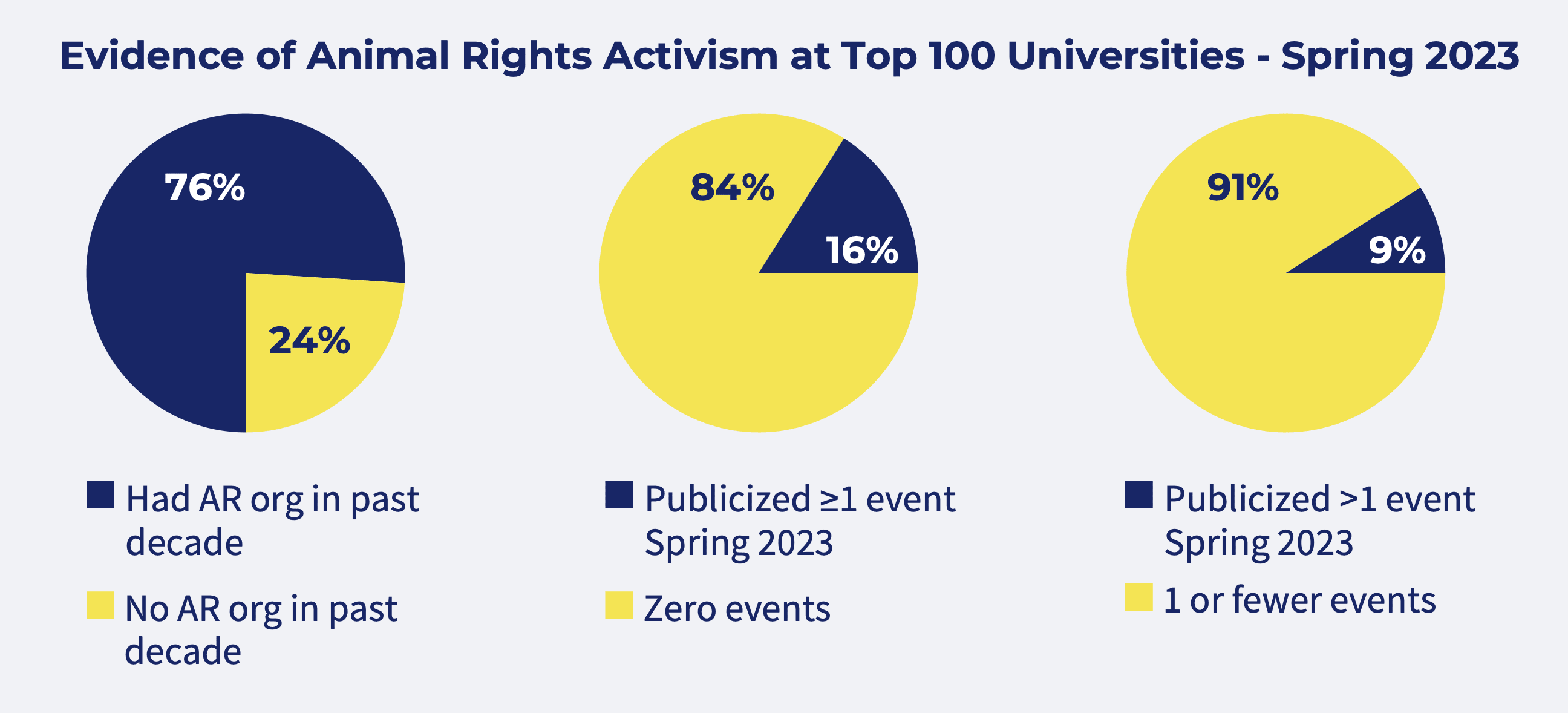
Second, we determined which of these animal rights organizations are currently active. Out of the 76 universities with animal rights groups, just 16 were currently active, i.e. held at least one event in Spring of 2023 (Figure 1). That means 84 of the top 100 universities held no animal advocacy events in Spring 2023.
Finally, we checked how many active universities held more than a single recent event, i.e. two or more. Of 16 active universities, only nine held more than one event recently. Out of the top 100 universities, 91 either held only one event or were completely silent (Figure 1).
We then focused on the top 10 American universities, whose graduates may have particularly influential careers. While seven of these top 10 had an animal rights or vegan student organization, only three are active, and only two held more than one event between January and May of 2023 (Figure 2).
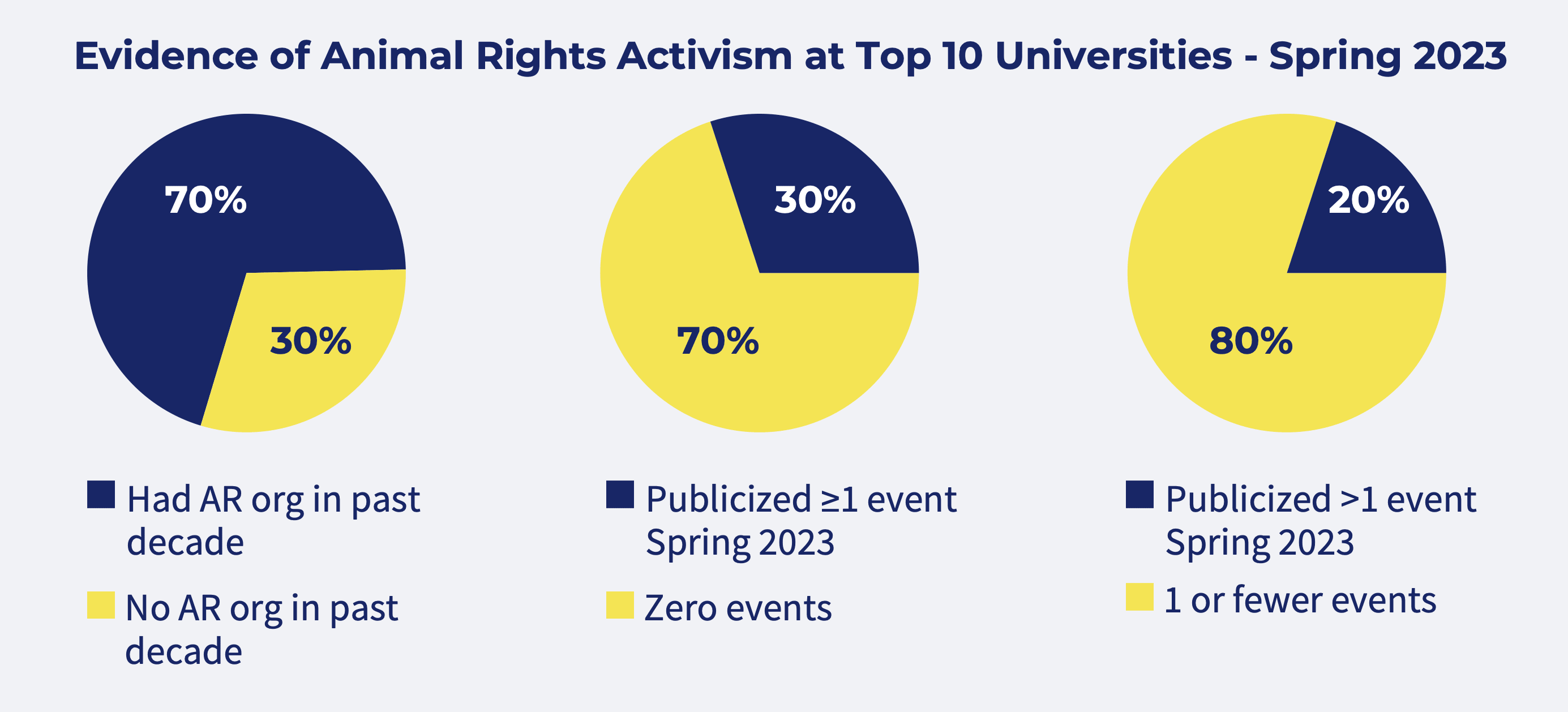
How Often Do Active Groups Hold Events?
We then looked more closely at active universities and analyzed the number of events they held recently, to evaluate the overall efficacy of their animal advocacy.
Among the 16 active universities, nearly 50% held just one animal rights activist event last semester. The distribution from there is skewed rightward: 75% of active universities held two or fewer events, and about 90% held three or fewer. This means that just two out of the top 100 universities held more than three animal rights advocacy events in the first five months of 2023 (Figure 3).
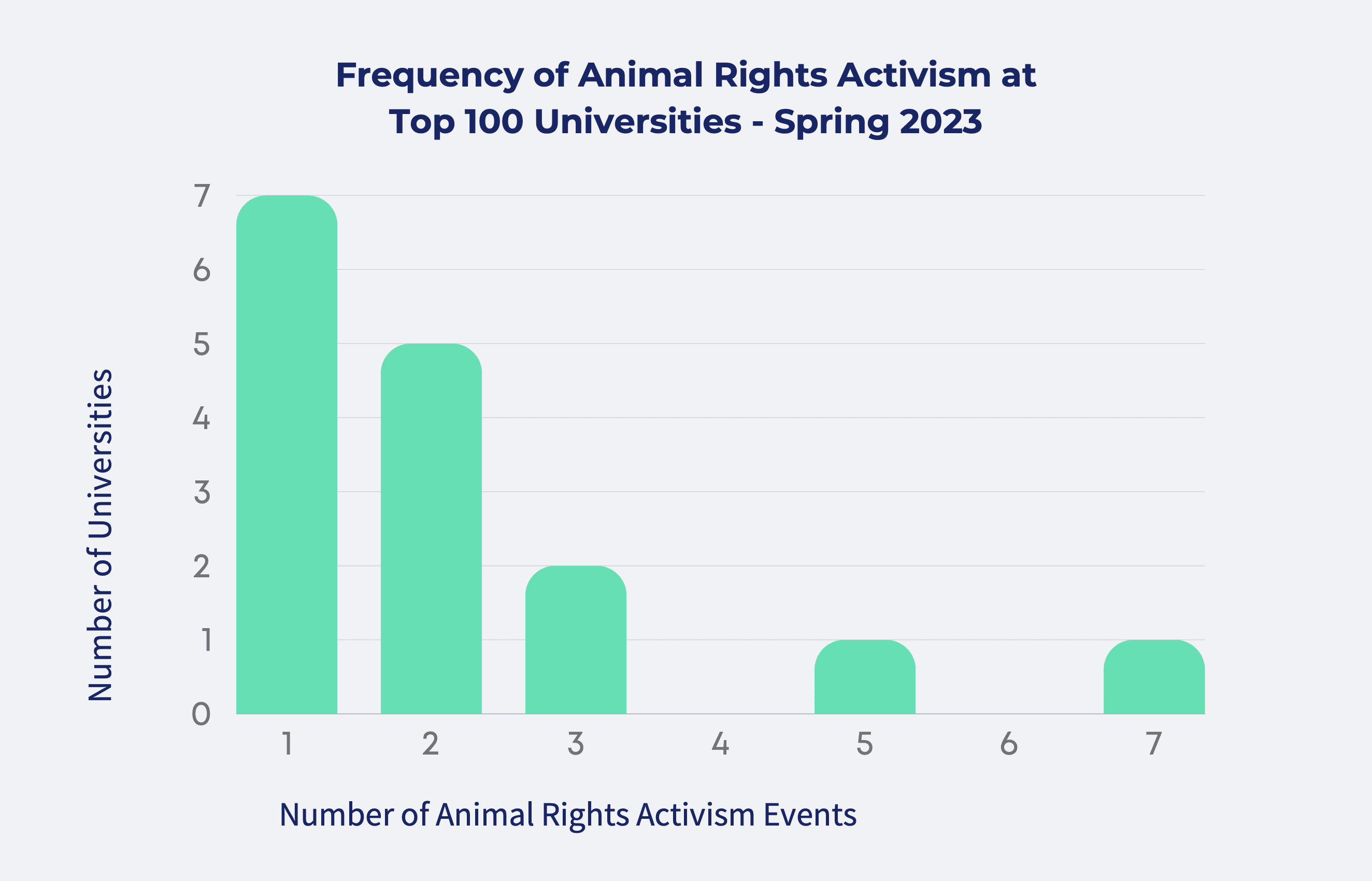
Focusing again on the top 10 universities: Seven had no animal rights activism events, one held a single event, and two held two events. None of the top 10 American universities held more than two animal advocacy events between January and May 2023.
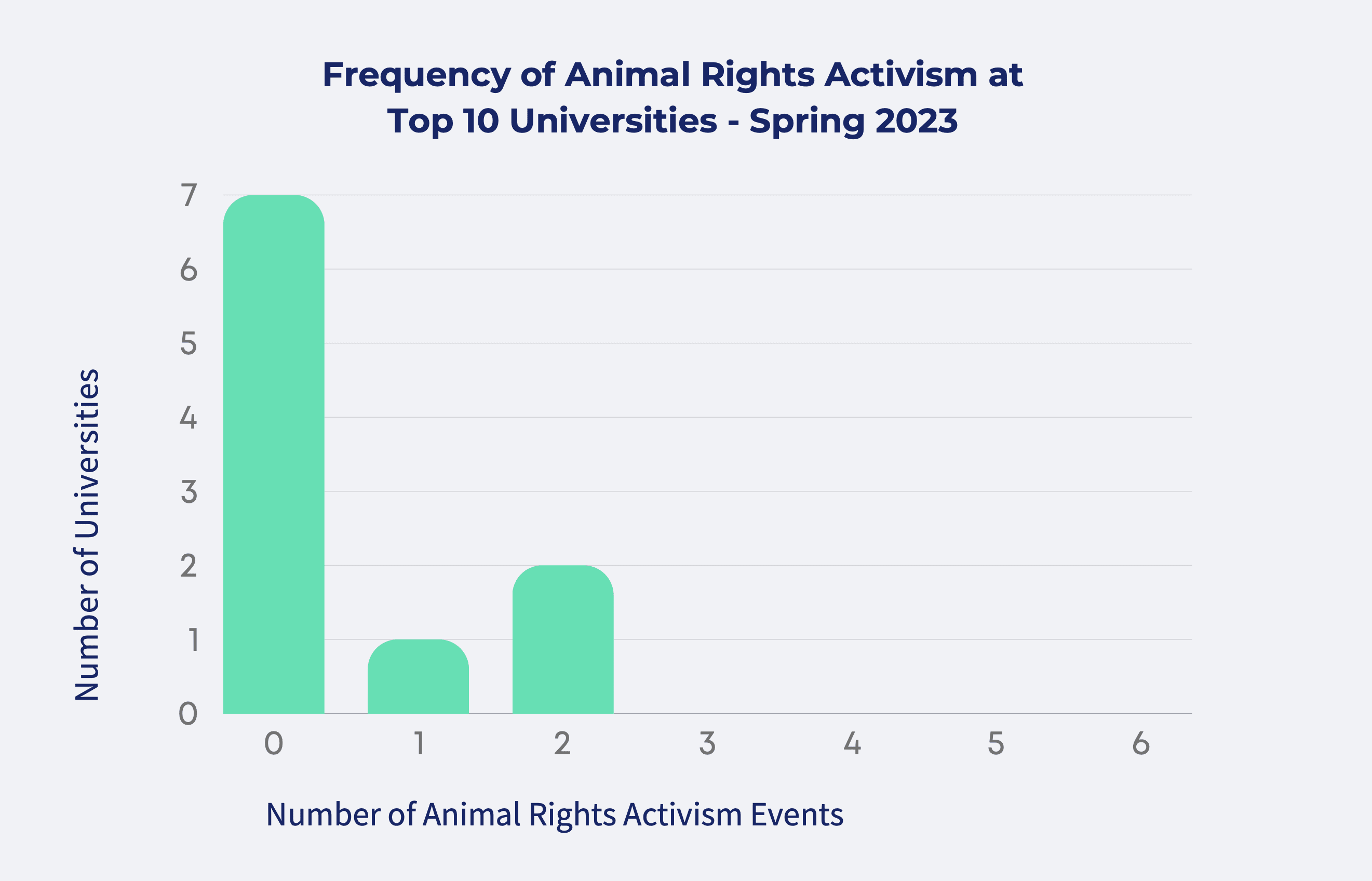
Discussion
From the results, we see:
- Most college animal advocacy organizations are inactive, indicating a lack of sustainability. While 76% of top colleges once had active animal rights organizations, fewer than 20% of colleges are currently active, and fewer than 10% held more than a single event in the first five months of 2023.
- Most active organizations held only one or two events last semester. Of 16 active universities, just four held more than two events, and just two held more than three events between January and May of 2023.
- The top 10 universities are similarly inactive and are even less effective. Of these, 70% saw no animal rights activism, and none held more than two events in Spring 2023.
What Does Effective Movement-Building Look Like?
Ours is not the first movement to see campus organizing as an important avenue for making an impact. We have considered several other campus organizing structures as models from which we can learn best practices for building a university movement.
The Federalist Society
The Federalist Society is a conservative and libertarian legal organization in the U.S. It has achieved significant influence in just 41 years of existence, with 6 out of 9 Supreme Court justices affiliated, chapters in 200+ law schools, and 60,000+ members.
Methods
- Centralized structure. Student chapters across law schools provide a platform for discussing legal philosophy and constitutional interpretation.
- On-the-ground organizing by student leaders. Unpaid student leaders facilitate discussions on legal topics and conservative values.
- Conferences and events. Chapters host lectures, debates, and conferences.
- Professional networking. An alumni network helps place law students in influential positions, contributing to the society's impact on legal circles.

Cru
Cru, formerly known as the Campus Crusade for Christ, is a large evangelical Christian organization founded in 1951. It operates globally with over 1700 chapters and annual revenue exceeding $600 million.
Methods
- Centralized structure. Cru maintains consistency across its chapters through established guidelines and protocols. Chapters base their individual constitutions on a Model Constitution, and leaders must agree to a "Leadership Covenant" to affiliate with the organization.
- On-the-ground organizing by paid staff members. Cru hires campus- specific staff to lead on-campus efforts, managing outreach, Bible studies, and programs.
- Standardized fellowship/education. Most students initially get involved with Cru through its Bible studies.
- Consistent outreach. Emphasizing evangelism, Cru focuses on creating personal connections and is recognized for its campus outreach.
- Conferences and events. Cru organizes events that unite Christians from diverse backgrounds, fostering worship, teaching, and community building.
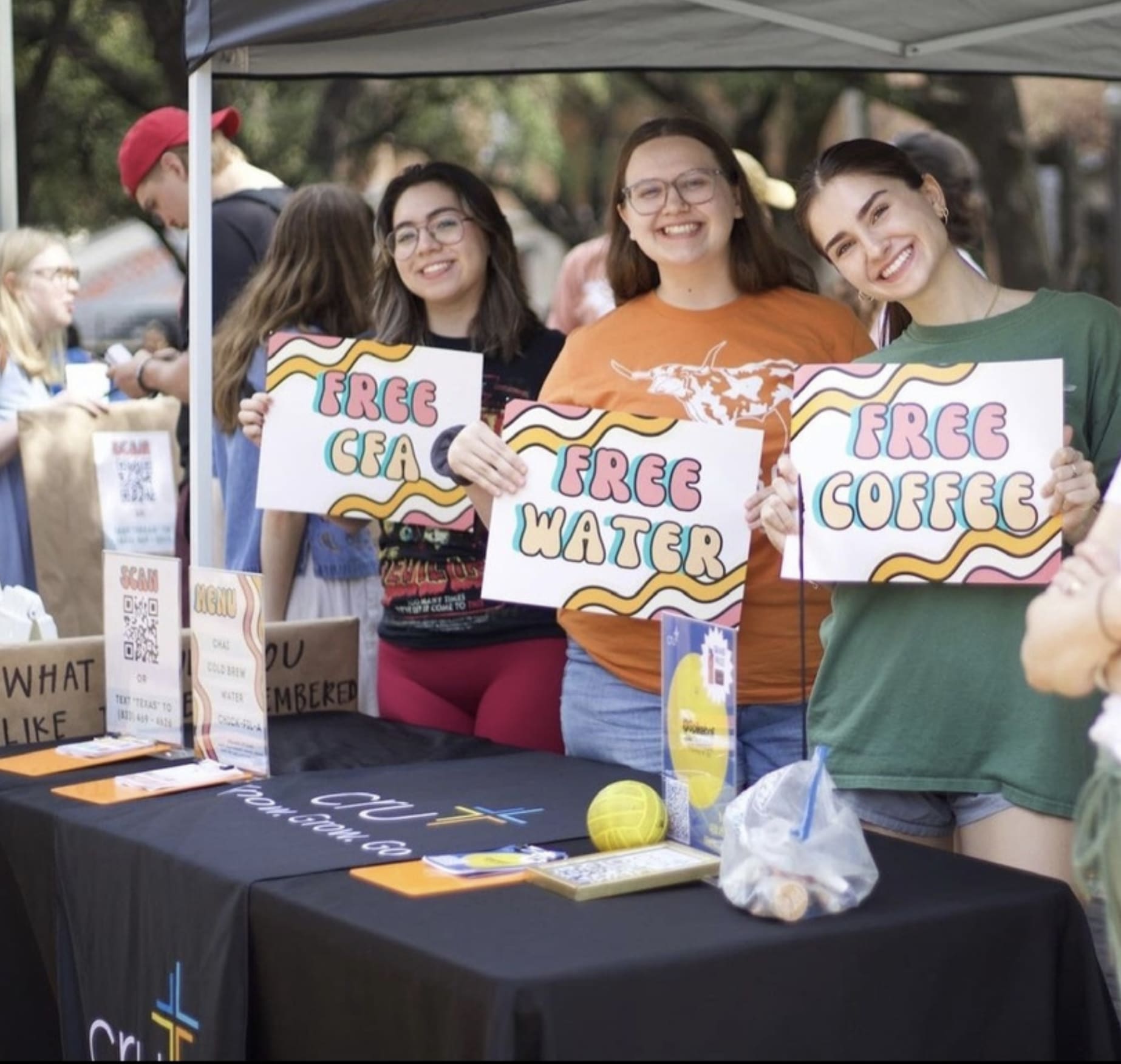
The Good Food Institute
The Good Food Institute (GFI) recognizes the importance of students in shaping the future of the food system and has established the Alt Protein Project (APP) student groups to create a talent pipeline for the alternative protein industry.
Methods
- Centralized structure. GFI manages its student groups centrally, setting clear expectations for student leaders' time commitment and responsibilities.
- Standardized program. Each student group receives consistent GFI- branded materials, and student leaders undergo training to understand GFI's mission and priorities. Groups submit regular impact reports and strategic plans.
- Conferences and events. APP student leaders gain priority access to GFI conferences and events.
- Professional network. GFI provides resources related to the alternative protein sector, along with professional guidance and mentorship, assisting students in pursuing careers aligned with their values.
- Mentorship and training. Student leaders can meet with GFI mentors and they participate in APP’s annual online training.
Effective Altruism Community Building
The Effective Altruism (EA) Community places significant emphasis on community building, recognized as a priority by 80,000 Hours. The community has invested over $290 million in movement building since 2012, fostering the growth of over 300 EA groups globally, with many located in universities.
Methods
- Centralized structure. EA student groups receive support through programs like the University Group Accelerator and can access a vast array of resources.
- Paid student organizers. Funding from Open Philanthropy and CEA enables paid student organizers to focus on community building, enhancing outreach and engagement efforts.
- Standardized fellowship/education. University EA groups utilize "fellowships" as a primary mode of engagement, involving weekly readings and discussions.
- Consistent outreach. CEA guides student group leaders in effective outreach strategies, crucial for attracting participants to EA fellowships.
- Conferences and events. CEA supports students attending EA Global and related conferences, facilitating networking and exposure.
- Professional network. Students are connected with EA professionals through resources like 80,000 Hours and Effective Thesis.
Limitations
- Elite school focus. Some have suggested a need for more attention to large state schools, rather than solely top-ranked schools.
- Little concrete action. EA groups often emphasize reading and discussions, potentially sidelining tangible action.
The Animal Legal Defense Fund
The Animal Legal Defense Fund (ALDF) establishes student chapters in law schools to foster interest in animal rights and cultivate a talent pool for legal work in the field.
Methods
- Centralized structure. ALDF's student chapters utilize the organization's branding and align with its larger objectives.
- Standardized program. Each year, ALDF selects a priority issue for all student groups to address. A Program Guide provides information, project suggestions, and forms for guest speakers.
- Conferences and events. ALDF hosts an annual student convention and general Animal Law Conference, offering networking opportunities and travel grants for attendees.
- Professional network. ALDF's student programming connects law students with career opportunities, resources on animal law writing, and post-graduation membership in ALDF's Pro Bono Program.
Limitations
- Exclusive focus on law schools. ALDF may miss students in other professions who could contribute valuable insights to the animal advocacy movement.
- Mostly virtual support. ALDF's support is primarily virtual, offering guest speakers and resources, but lacking in-person training and support.
Vegan Outreach
Vegan Outreach (VO) is an animal rights organization focused on individual outreach to build the vegan movement across the globe. Importantly, VO has maintained a significant focus on outreach at college campuses, reaching up to 1 million students at 1,000 schools some semesters.
Rather than setting up registered student organizations at colleges, VO sends staff and volunteers to its campuses to speak with passerby individually.
VO has grown internationally, focusing heavily on India and Latin-speaking countries as well as online targeted approach. VO operates with a decentralized approach, relying heavily on volunteers.
Methods
- Centralized structure. VO employs standardized leaflets and resources for its outreach efforts across various locations.
- On-the-ground organizing. Instead of virtual support, VO conducts in- person outreach on college campuses, engaging with passersby individually.
- Consistent outreach. Similar to Cru, VO strives for a noticeable presence on campuses, focusing on direct engagement to raise awareness.
Limitations
- Limited student involvement. VO's approach doesn't involve creating official student chapters, setting it apart from other programs.
- No infrastructure beyond outreach. By restricting itself to individual outreach, VO engages with students less deeply than GFI or ALDF, for example.
Other Attempts at Sparking a Campus Animal Rights Movement
Several animal rights organizations have initiated campus programs in the past. For instance, The Humane League and PETA have implemented campus representative programs paying students to engage in advocacy.
Challenges
- Insufficient Support. Campus programs are often managed by a single staff member remotely.
- Deprioritization. These programs tend to align with the parent organization's agenda, potentially neglecting the development of a lasting vegan community on campus. Gathering signatures for corporate pressure campaigns is a good example of this.
- Branding. Campus animal rights groups historically had different names, branding, and foci, hindering a cohesive and effective movement. Coordinating under a common brand could enhance visibility and coordination. All example movements described herein maintain consistent branding.
- Remote. While remote support is common, in-person training and engagement yield better results.
- Lack of Ambition. Past programs focused on individual advocates rather than community-focused interventions.
- Unpredictable missions. Diverse missions and causes among campus animal advocacy groups lead to incoherence, weakening the movement's impact.
Vegan Movement Building Has Unique Challenges
We recognize that building a robust campus animal movement will require overcoming significant hurdles not faced by other groups. For instance, The Federalist Society and Cru promote one of America’s most popular ideologies and the world’s most popular religion, respectively. The vegan movement, meanwhile, promotes a lifestyle practiced by less than 5% of Americans.
The animal rights movement is also far more funding-constrained than the other movements we have considered. The entire farmed animal advocacy movement has roughly $200 million to work with each year, while Cru alone brings in over $600 million annually. The Federalist Society’s 2021 revenue was $22 million, more than 10% of the farmed animal advocacy movement’s annual spending. The EA movement spends over $600 million annually, excluding its spending on animal welfare.
Thus, we must somewhat temper our expectations for vegan movement building and recognize that the animal rights movement simply does not currently have the resources enjoyed by Christians or libertarian conservatives.
Reasons for hope
Nonetheless, we believe animal advocates have much to gain from constructing a robust campus network. Given that current investment in building a unified infrastructure for campus advocacy is close to zero, there is much low-hanging fruit to be harvested.
To quantify the potential impact, imagine a large state university with 35,000 students. If 14% of these students are vegan or vegetarian, then nearly 5,000 students may be susceptible to animal rights arguments. If 10% of those 5,000 are interested in activism or impactful careers, then 500 may be mobilized by a student group.
At a small, elite private school with 10% as many students, the figure is nearly 50 potential advocates – a meaningful number for such a small movement.
Many of the students reached by such a program would go on to hold influential positions in government and business, and some might become major donors. Ideally, this can yield a positive feedback mechanism whereby outreach and education lead to movement growth, which leads to more outreach, and so forth. This mechanism is part of why alumni relations are so important to universities, Greek organizations, and groups like the Federalist Society. The animal advocacy movement would be wise to invest in such a potent source of growth.
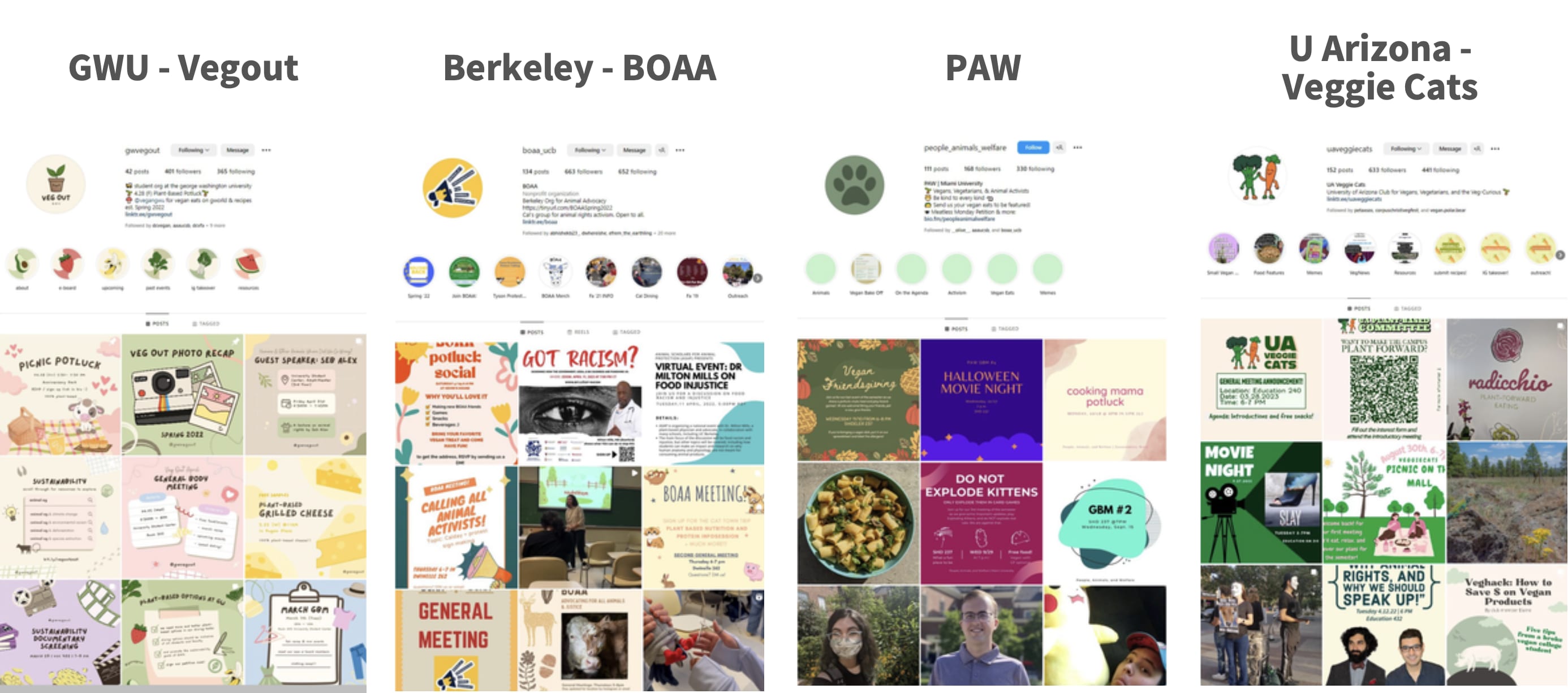
Survey of Professional Animal Advocates
We spoke to several animal advocacy professionals about their experiences with campus animal advocacy and their views on the current campus advocacy ecosystem. Many said that they founded campus groups while they were students, before going on to work in the movement full time.
Several respondents noted the difficulty of starting and maintaining an active student group.
- Aidan Kankyoku of Pax Fauna: “I think what campus groups are lacking is direction and strategy.”
- Zoe Rosenberg of UC Berkeley and Direct Action Everywhere: “I've found that recruitment efforts in person (tabling) are the most impactful. We try to do weekly meetups, one protest per-month, and one animal rescue volunteer day per-month. It works well for the most part, but getting people to turn out to do activism is the most difficult.”
- Jenna Holakovsky of Farm Sanctuary: “We wanted to do a lot, but atop lack of funding, student schedules are massively draining, random, and not always reliable. This left us with some limitations. Longevity is also an issue. Sometimes it's difficult to pass the torch to the next person as leadership cycles every 1-4 years (typically) given the nature of being a college student.”
- Anonymous movement leader: “If a passionate student advocate arrives on a college campus, they should be able to easily connect with the key influencers and active groups without needing to conduct extensive research. If this isn't the case, then we have failed them by not making it simple for them to engage.”
All but one of our seven respondents said they think there is currently insufficient support for animal rights advocacy at colleges in the US, and that the Animal Rights Movement should invest more in campus advocacy.
Similarly, all but one respondent rated the current effectiveness of campus Animal Rights activism as below 5 on a scale of 1 to 10, with 10 being most effective. We also asked respondents to rate the importance and neglectedness of campus advocacy on a scale of 1 to 10, with 10 being the most important/neglected. On average, respondents rated its importance at 9/10, and neglectedness at 7.5/10.
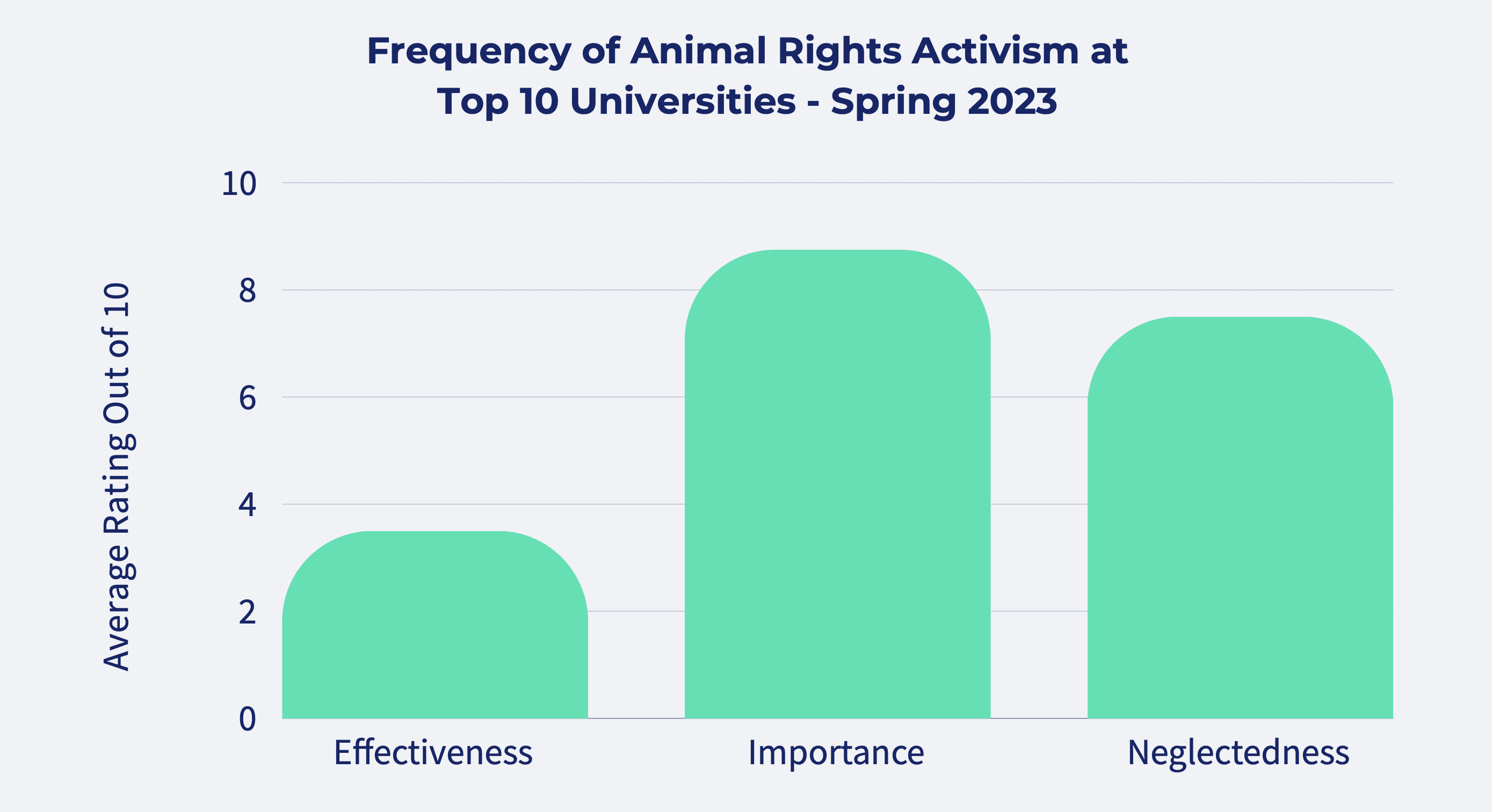
- Anonymous movement leader: “It's surprising that New York City doesn't have a thriving college advocacy scene. Dozens of students should be delivering humane education presentations on their campuses, hosting plant-based potlucks for community building.”
Conclusion
We need a united front in student animal advocacy, and we need it now. Left by themselves, even our nation’s top universities have failed to host consistent, effective, enduring animal rights activism on their campuses. In fact, the vast majority host none at all. We have no reason to believe this will get any better on its own and many reasons to believe it is solvable.
There are 15.4 million undergraduate students in the US. Each of these students is learning about the world and determining their long-term priorities. This makes campus organizing a crucial ingredient for animal liberation.
Yet animal advocacy in colleges remains sporadic, impotent, and unsustainable, with each group having its own – mostly ineffective – approach. Students graduate and the next batch is left to reinvent the same (infective) wheel. 76 universities had an active group at some point in the last 10 years, but the overwhelming majority of groups die out in short order. Imagine if these groups had enough support to stay on, and if they benefited from the organization and branding that other movements have implemented. Imagine how much farther along our movement would be today if infrastructure for this had existed 20 years ago.
Allied Scholars for Animal Protection (ASAP) is addressing the problem of ineffective and disorganized animal advocacy in the top 100 universities, which are failing the next generation of talented students. Our goal is to provide a systematic solution by implementing orchestrated and lasting efforts, training, education, and effective outreach strategies.
We note that both of the universities which held more than three events during the study period – UT Austin (seven events) and UC Berkeley (five events) – are ASAP chapters or affiliates.
Universities hold immense potential and talent, yet the existing infrastructure fails to harness and channel this potential towards impactful careers. ASAP is determined to rectify this by creating a framework that enables students to utilize their abilities and contribute to meaningful change.

Caveats & Limitations
We were limited to information available on Google and social media. Thus, we could not account for events publicized through email, Discord, or other private platforms.
However, we note that if an organization is not present on social media, and is not even web searchable, then they are likely not as effective as they could be. More work needs to be done to fully leverage such a student group’s potential.
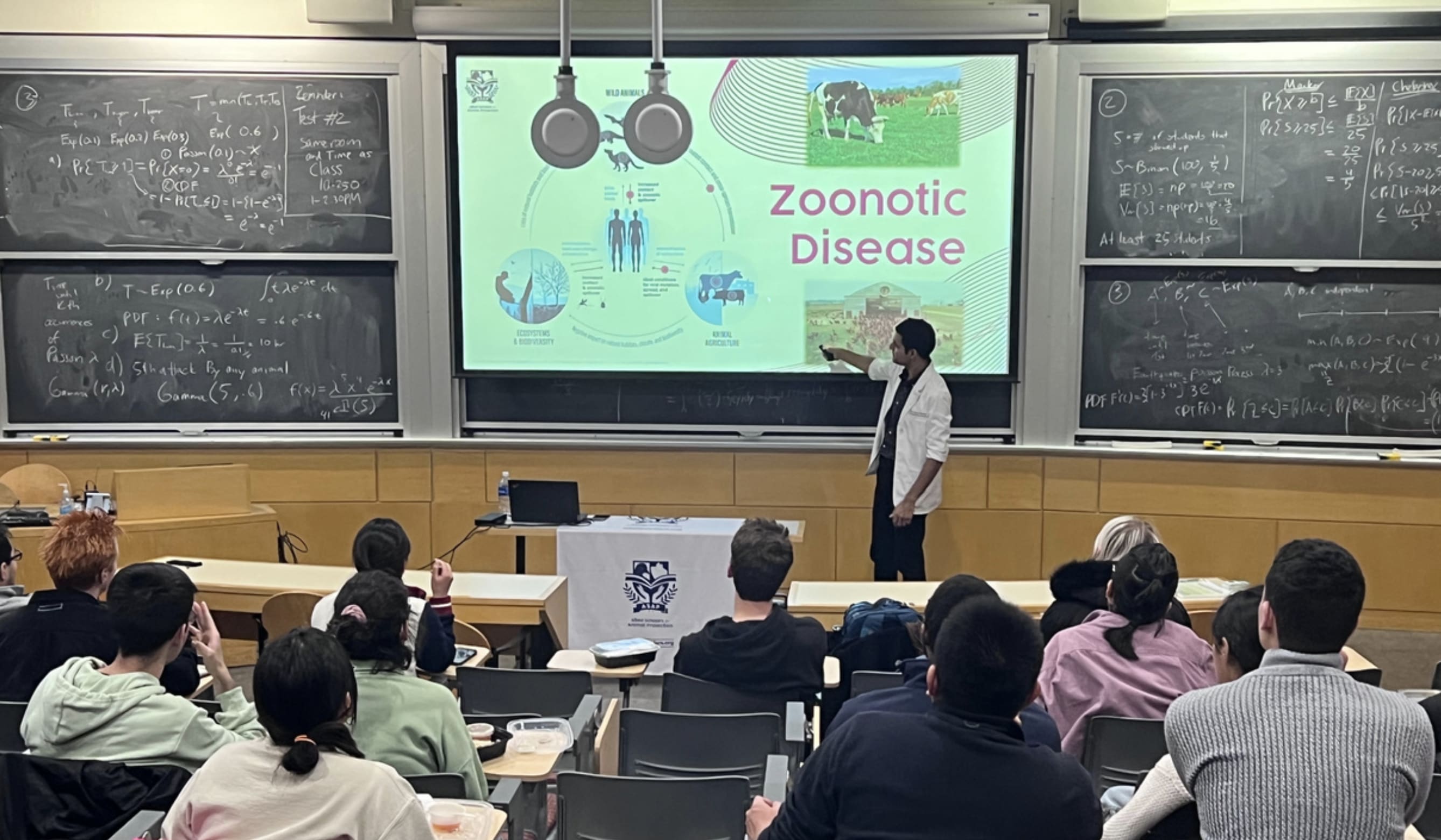
- ^
We value community building and social events, and we believe they can play an important role in creating a lasting vegan community within a university, as long as they are integrated into broader initiatives. For example, if these social events lead to group discussions, career exploration, petition signing, or other meaningful actions.
But as we will demonstrate, placing exclusive emphasis on social events alone does not motivate students to become more engaged or pursue impactful careers. Additionally, such events do not effectively educate non-vegans, as they are primarily promoted within the vegan community, and typically only vegans attend the potlucks.

Thanks for the interesting summary of campus activism! A few questions that came to mind while reading this:
[Background: Spent time in a student chapter of the Federalist Society, and in somewhat Cru-like organizations, in the 2000s. My perspective is doubtless somewhat out of date, especially on FedSoc.]
Although looking at other movements is helpful, I would emphasize that each of them has a somewhat different theory of impact, special constraints, and target audience. Modeling after an existing successful movement may backfire if these factors do not align adequately. There are many different theories of impact that I think a campus animal-advocacy group could follow, and the lessons I might draw from other successful organizations would be pretty different based on the desired theory.
The other reaction I have to this report is curiosity: as a historical matter, why did the previous organizations at these institutions fail? Ideally, we would ask former organizers, although that could be fairly time-consuming.
I'll add a few points on Cru and FedSoc, mainly because I have more experience with them than most people here.
I mean stuff like -- at the extreme end -- the Peoples Temple of the Disciples of Christ that ended up in mass murder-suicide under Jim Jones.
Executive summary: Animal advocacy at top U.S. universities is largely inactive and ineffective, with only 16% of the top 100 schools having active groups and fewer than 10% holding more than one event in early 2023, indicating a need for a united, sustainable approach to campus animal rights activism.
Key points:
This comment was auto-generated by the EA Forum Team. Feel free to point out issues with this summary by replying to the comment, and contact us if you have feedback.